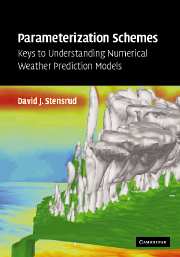Book contents
- Frontmatter
- Contents
- Preface
- List of principal symbols and abbreviations
- 1 Why study parameterization schemes?
- 2 Land surface–atmosphere parameterizations
- 3 Soil–vegetation–atmosphere parameterizations
- 4 Water–atmosphere parameterizations
- 5 Planetary boundary layer and turbulence parameterizations
- 6 Convective parameterizations
- 7 Microphysics parameterizations
- 8 Radiation parameterizations
- 9 Cloud cover and cloudy-sky radiation parameterizations
- 10 Orographic drag parameterizations
- 11 Thoughts on the future
- References
- Index
9 - Cloud cover and cloudy-sky radiation parameterizations
Published online by Cambridge University Press: 05 September 2013
- Frontmatter
- Contents
- Preface
- List of principal symbols and abbreviations
- 1 Why study parameterization schemes?
- 2 Land surface–atmosphere parameterizations
- 3 Soil–vegetation–atmosphere parameterizations
- 4 Water–atmosphere parameterizations
- 5 Planetary boundary layer and turbulence parameterizations
- 6 Convective parameterizations
- 7 Microphysics parameterizations
- 8 Radiation parameterizations
- 9 Cloud cover and cloudy-sky radiation parameterizations
- 10 Orographic drag parameterizations
- 11 Thoughts on the future
- References
- Index
Summary
Introduction
The amount of sky covered by clouds, or cloud cover, can substantially alter the amount of radiation received at the Earth's surface, thereby influencing atmospheric circulations and climate. Clouds both reflect and absorb shortwave radiation, altering the total albedo. Under overcast skies, the reduction in the incoming shortwave radiation due to the clouds can be substantial. In addition, clouds absorb and emit longwave radiation in the atmospheric window, the wavelength band in which the atmosphere is almost transparent to longwave radiation. The ability of clouds to alter substantially both the shortwave and longwave radiative transfer highlights their importance to numerical weather prediction across a range of spatial and temporal scales.
Small-scale atmospheric circulations develop in response to horizontal differential heating as discussed in Chapter 2. Horizontal variability in cloud cover can lead to surface differential heating and the development of mesoscale thermally induced circulations between cloudy and clear areas (Koch 1984; Segal et al. 1986). These circulations can reach magnitudes similar to those associated with sea breezes with the potential to aid in both the development of deep convection and frontogenesis across weak or moderate cold fronts (Koch 1984; Keyser 1986; Segal et al. 1986, 1993; Businger et al. 1991). Segal et al. (1986) further argue that even short-lived episodes of cloudy–clear air contrasts can lead to changes in the low-level wind fields. The effects of cloud shading underneath thunderstorm anvils may be important to the evolution of thunderstorms (Markowski and Harrington 2005).
- Type
- Chapter
- Information
- Parameterization SchemesKeys to Understanding Numerical Weather Prediction Models, pp. 346 - 372Publisher: Cambridge University PressPrint publication year: 2007
- 1
- Cited by



